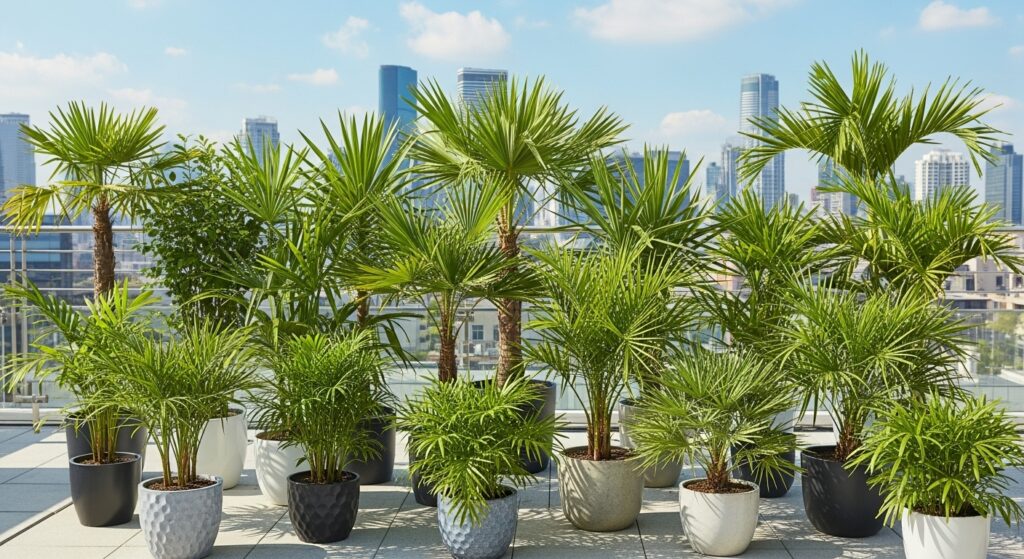I. Introduction
In the urban jungles, rooftop gardens have evolved from a novel idea into a full-blown movement, breathing life into bare rooftops and transforming them into green sanctuaries. These elevated spaces not only enhance the cityscape visually but also promote sustainability by improving air quality, reducing urban heat, and providing habitats for various city-dwelling flora and fauna. Among the countless plants suitable for rooftop gardens, various types of palm trees stand out as some of the most popular choices, thanks to their exotic appeal, the striking architectural element they offer, and their ability to turn any space into a tropical escape.
Different types of palm trees with their classical forms and abundant foliage emplace to any rooftop a subtle atmosphere of calmness and refinement. They are the flexible plants which can be combined with the modern minimalist style, and the flourish and greenery of the traditional garden. By transforming the roofs over your head into luxurious logia for relaxation or into dazzling terraces for fun time during social activities, palm trees may be the solution that you seek. Their presence in the US and UK is greatly aided by the fact that they are pretty much adaptable to different climates, and they can be the most beautiful choice to plant in the cities.
On the other hand, rooftop gardening is not like going on a picnic. It has many challenges and issues if not tackled correctly, as they include limited space, high wind exposure, and weight restrictions. The decision about which palm tree to plant is essential for the long-term success of the rooftop garden.
This blog lists 15 captivating types of palm trees for the rooftop garden, and it provides a good amount of information about the trees’ growing habits, their care and needs, and also about the suitable climate. Conclusively, you will be able to educate yourself on transforming your rooftop into a green tropical heaven.
II. What Makes a Palm Tree Rooftop-Friendly?
The selection of the palm tree for the rooftop garden is essential and must be made with utmost care and diligence to address both plant health issues and structural safety concerns.
Here are the major characteristics that make a palm tree roof-friendly:
Compact or Slow-Growing Varieties:
Most rooftop gardens are characterized by limited space, which is why compact or slow-growing palms are perfect for these types of situations. They also help to avoid overcrowding and reduce the risk of outgrowing containers or compromising rooftop structures.
Climate Tolerance:
Rooftops are exposed to more severe environmental factors, which include strong winds and temperature fluctuations. Under these circumstances, palms that endure wind and frost winds better have the possibility of successful growth.
Shallow Root Systems:
Many types of palm trees have fibrous, shallow roots, making them compatible with container planting, which is a necessity for rooftop gardens where soil depth is limited.
Aesthetic Appeal:
Fronds give palm trees their visual appeal, with their vibrant colors and striking shapes making them ideal for rooftop gardens, eye-catching focal points, and complementing other plants.
Low Maintenance:
Rooftop gardens should be easy to maintain. For busy urban dwellers, the types of palm trees that require minimal pruning, watering, and fertilizing are the ideal choice.
Weight Considerations:
There are weight limits for rooftop structures. To avoid conflicts with structural guidelines, consider lightweight containers and palms that have moderate growth habits.
Keeping these points in mind, you can make an informed decision on which palm trees to select so they flourish well in the special environment of a rooftop garden.
III. 15 Types of Palm Trees Perfect for Rooftops
The following list contains 15 types of Palm Trees Perfect for Rooftop Gardens, featuring the best palm varieties for rooftop spaces, along with detailed care tips and climate considerations for each.
1. Pygmy Date Palm (Phoenix roebelenii)
The Pygmy Date Palm is the smallest tree with a mostly hidden trunk, which grows a few delicate, feathery leaves. This slow-growing palm reaches a height of 6 to 12 feet and is an excellent choice for bringing a touch of the jungle to a small rooftop without overwhelming the space. This palm tree has strong and feathery leaves which provide a green effect and are lightweight, which do not affect the area much.
- Container Tips: Use a lightweight, well-draining pot to prevent root rot. Ensure the container has drainage holes and is placed on a stable surface to withstand wind.
- Sunlight and Care Requirements: This tree thrives in partial shade to full sun. Water it regularly, allowing the soil to dry slightly between waterings. Apply a slow-release palm fertilizer every 3 to 4 months.
- Climate Suitability: Hardy in USDA Zones 9–11, it tolerates mild frost but may require protection in colder UK winters.
- Unique Feature: Its compact size and graceful fronds make it a versatile addition to both modern and tropical garden designs.
2. Areca Palm (Dypsis lutescens)
The Areca Palm or the Butterfly Palm is another fantastic palm tree for the rooftop garden. This palm tree features swing-shaped feather fronds that are reminiscent of butterfly wings. In containers or pots, it grows up to 10 feet and adds a vertical dimension to top gardens.
- Container Tips: Choose a slightly larger pot to accommodate its clumping growth habit. Ensure good drainage to prevent waterlogging.
- Sunlight and Care Requirements: Prefers bright, indirect light but can tolerate some direct sun. Keep soil consistently moist but not soggy, and mist fronds to maintain humidity.
- Climate Suitability: Best suited for USDA Zones 10–11. In the UK, protect from frost by moving indoors or using frost cloth during winter.
- Unique Feature: Its lush, clumping growth creates a natural privacy screen for rooftop spaces.
3. Lady Palm (Rhapis excelsa)
Lady Palm trees have fan-shaped leaves, they have a glossy look and have an elegant, upright growth. Reaching a height of 6-8 feet, the lady palm is excellent for compact rooftop gardens.
- Container Tips: Use a sturdy, well-draining pot to support its upright structure. A decorative container enhances its aesthetic appeal.
- Sunlight and Care Requirements: Thrives in low to moderate light, making it ideal for shaded rooftops. Water consistently, keeping soil moist but not waterlogged.
- Climate Suitability: Hardy in USDA Zones 8–11, it adapts well to cooler UK climates with proper winter protection.
- Unique Feature: Its bamboo-like stems and fan-like leaves add a touch of Asian-inspired
- elegance.
4. Sago Palm (Cycas revoluta)
The Sago Palm is not a true palm. But it is one of our simple palm species; sago plants boast a rosette of stiff, feathery foliage that looks just like a palm. It is an excellent species for the rooftop as the leafy ornament grows little and is compact (up to 6 feet).
- Container Tips: Opt for a shallow, wide container to accommodate its shallow root system. Ensure excellent drainage to prevent rot.
- Sunlight and Care Requirements: Requires bright light, tolerating some direct sun. Water sparingly, as it is drought-tolerant.
- Climate Suitability: Hardy in USDA Zones 8–11, it can withstand cooler temperatures with minimal protection.
- Unique Feature: Its prehistoric appearance adds a dramatic, sculptural element to rooftop gardens.
5. Parlor Palm (Chamaedorea elegans)
Parlor Palm is a bushy, small palm with delicate, arching fronds and can successfully counteract the rooftop space with its soft tropical vibe. It typically grows to 4–6 feet in containers.
- Container Tips: Use a decorative pot with good drainage to highlight its beauty. Ensure the container is lightweight for easy movement.
- Sunlight and Care Requirements: Prefers indirect light and moderate humidity. Water regularly, keeping the soil slightly moist.
- Climate Suitability: Suitable for USDA Zones 10–12, it thrives in temperate climates and can be brought indoors in colder regions.
- Unique Feature: Its compact size and low light tolerance make it ideal for shaded rooftop corners.
6. Windmill Palm (Trachycarpus fortunei)
Windmill palm is recognized as one of the most resistant members of the family of palms. It has fan-like leaves and a slim trunk; the growth height of this tree reaches 10-15 feet, which makes it suitable for larger rooftop gardens.
- Container Tips: Use a deep, well-draining pot to support its fibrous roots. A heavy base prevents tipping in windy conditions.
- Sunlight and Care Requirements: Thrives in full sun to partial shade. Water moderately, allowing soil to dry between waterings.
- Climate Suitability: Hardy in USDA Zones 7–11, it’s an excellent choice for colder UK climates.
- Unique Feature: Its cold tolerance and wind resistance make it a reliable choice for exposed rooftops.
7. Bamboo Palm (Chamaedorea seifrizii)
Bamboo Palm is a very popular palm plant to grow in all types of conditions; it thrives best with water from the ground. This is a small, narrow palm with bamboo-like stems and lush, green fronds, growing up to 7 feet in containers. It adds a tropical, airy feel to rooftops.
- Container Tips: Choose a wide pot to accommodate its clumping growth. Ensure proper drainage to prevent root issues.
- Sunlight and Care Requirements: Prefers low to medium light and high humidity. Keep soil consistently moist and mist fronds regularly.
- Climate Suitability: Suitable for USDA Zones 9–11, it requires indoor protection in colder UK winters.
- Unique Feature: Its bamboo-like appearance creates a serene, Zen-like atmosphere.
8. European Fan Palm (Chamaerops humilis)
The European Fan Palm is a multi-trunked palm with fan-shaped leaves, growing to 8–10 feet. Its robust structure makes it a standout choice for rooftops.
- Container Tips: Use a heavy, well-draining pot to support its sturdy growth. Ensure stability to withstand the wind.
- Sunlight and Care Requirements: Requires full sun for optimal growth. Water occasionally, as it is drought-tolerant.
- Climate Suitability: Hardy in USDA Zones 7–11, it thrives in both US and UK climates with minimal protection.
- Unique Feature: Its multi-trunked form adds architectural interest to rooftop designs.
9. Bottle Palm (Hyophorbe lagenicaulis)
The Bottle Palm is named for its distinctive bottle-shaped trunk and sparse crown of fronds. It remains compact, reaching up to 10 feet in height.
- Container Tips: Use a sturdy pot with excellent drainage to support its unique structure. Ensure stability to prevent tipping.
- Sunlight and Care Requirements: Needs bright, indirect light and moderate watering. Allow the soil to dry slightly between waterings.
- Climate Suitability: Best suited for USDA Zones 10–11, it can be grown indoors in cooler climates during winter.
- Unique Feature: Its sculptural trunk makes it a striking focal point for rooftop gardens.
10. Triangle Palm (Dypsis decaryi)
The Triangle Palm is known for its unique, triangular trunk and arching fronds. It grows slowly, reaching up to 15 feet in containers.
- Container Tips: Use a large, stable pot to accommodate its growth. Ensure excellent drainage to prevent root rot.
- Sunlight and Care Requirements: Requires full sun and well-drained soil. Water moderately, avoiding overwatering.
- Climate Suitability: Best for USDA Zones 10–11, it can be grown in greenhouses in cooler UK climates.
- Unique Feature: Its triangular trunk adds a bold, geometric element to rooftop designs.
11. Majesty Palm (Ravenea rivularis)
The Majesty Palm is a fast-growing palm with graceful, arching fronds, reaching up to 10 feet in containers. It adds a majestic presence to the rooftop garden.
- Container Tips: Use a large pot with rich, well-draining soil to support its rapid growth. Ensure stability for larger specimens.
- Sunlight and Care Requirements: Needs bright, indirect light and consistently moist soil. Mist fronds to maintain humidity.
- Climate Suitability: Prefers USDA Zones 9–11 but can be grown indoors in cooler regions.
- Unique Feature: Its lush, tropical appearance creates a resort-like atmosphere.
12. Needle Palm (Rhapidophyllum hystrix)
The Needle Palm is a hardy, compact palm with needle-like fronds, rarely exceeding 6 feet. Its cold tolerance makes it ideal for rooftops in cooler climates.
- Container Tips: Use a durable pot with ample drainage to support its slow-growing roots. Ensure stability in windy conditions.
- Sunlight and Care Requirements: Tolerates full sun to partial shade. Water sparingly, as it is drought-tolerant.
- Climate Suitability: Hardy in USDA Zones 6–10, it’s an excellent choice for UK rooftop gardens.
- Unique Feature: Its needle-like fronds add a unique texture to rooftop gardens.
13. Kentia Palm (Howea forsteriana)
The Kentia Palm is a classic choice with elegant, feathery fronds, growing to 8–10 feet in containers. It’s a versatile option for rooftops.
- Container Tips: Choose a tall, narrow pot to accommodate its upright growth. Ensure good drainage to prevent root issues.
- Sunlight and Care Requirements: Prefers indirect light and regular watering. Keep the soil slightly moist but not soggy.
- Climate Suitability: Suitable for USDA Zones 9–11, it adapts to temperate climates with indoor winter protection.
- Unique Feature: Its graceful fronds add a touch of timeless elegance.
14. Dwarf Palmetto (Sabal minor)
A small clumping palm, the Dwarf Palmetto has fan-shaped leaves and a height of about 5 feet. This palm tree’s compact size is a great fit for small rooftops.
- Container Suggestions: A shallow pot with good drainage is needed to support its shallow roots. Ensure stability in windy conditions.
- Sunlight and Care Requirements: Full sun to partial shade is the ideal temperature. It rarely needs watering as it can survive droughts.
- Climate Suitability: Growing in USDA Zones 7-10, it can be found in both the US and UK territories.
- Unique Feature: The low height of the Dwarf Palmetto and its fan-like leaves make it perfect for tight spaces.
15. Miniature Fishtail Palm (Caryota mitis)
The Miniature Fishtail Palm is recognized by its fishtail-shaped fronds and bushy growth that goes up to 10 feet in containers.
- Container Tips: Use a wide pot to support its spreading roots. Ensure excellent drainage to prevent waterlogging.
- Sunlight and Care Requirements: Prefers bright, indirect light and high humidity. Keep soil consistently moist and mist fronds regularly.
- Climate Suitability: The best choice is USDA Zones 10-11, but it could be grown indoors in the cooler UK climates.
- Unique Feature: Its unique fishtail fronds add a tropical textured element to rooftops.
IV. Tips for Growing Palm Trees on Rooftops
Palm trees will flourish in a rooftop environment if you follow these essential tips:
- Select Lightweight Containers: Choose pots made of materials like fiberglass or plastic to keep the weight low. Make sure the containers have enough drainage holes to prevent waterlogging.
- Use palm-specific soil: Use a mix of peat, perlite, and sand that is well-drained, well-aerated, and made specifically for palms.
- Get into a watering routine: The majority of palms like consistently moist soil, but overwatering can cause them problems. Test with a finger and check soil moisture before watering and adapt according to weather conditions.
- Regularly fertilize: Feed them with a balanced, slow-release palm fertilizer (e.g. 8-2-12) that should be given every 3-4 months when they are in their active growth period to supply important nutrients.
- Wind Protection: Rooftops usually face strong winds. Trees, walls, etc., can be good windbreakers, or palm trees can be placed in sheltered spots for their better health.
- Weight Limits: Discuss with a structural engineer so you can find out if your rooftop can carry the containers, soil, and mature palms. Even distribution of weight must be followed to prevent stress points.
- Minimal Pruning: Only dead or yellowing fronds should be removed to maintain the plant’s health and appearance. Over-pruning can stress the palm and hinder its growth.
V. Common Mistakes to Avoid
Avoid the following mistakes to have a sustainable rooftop garden with flourishing palm trees:
- Choosing Large Palm Trees: Well-established trees often become a problem and are a threat to the integrity of the property’s structure. Pick small or slow-growing kinds.
- Too Much water: Overwatering or water in abundance may cause the roots to rot, which growing palms in containers frequently cope with. Always inspect soil moisture before watering.
- Ignoring Weight Restrictions: Overpacking your rooftop with heavy containers and plants causes a potential safety issue. Always examine the structural limits.
- Bypassing Winter Protection: In the cold weather, naked palms with no covering may face being frozen by the frost. Drape frost cloth, burlap, or move containers inside during winter.
- Poor Drainage: Without proper water circulation, palm roots can be crushed. Make sure that the pots have adequate drainage holes and that you use soil mixes with superior drainage.
- Insufficient Sunlight: Planting shade-loving palms in direct light or planting sun-loving palms in the shade will stunt their growth. Find the right light conditions and place the palm accordingly on the roof.
VI. Significance of Palms in Different Cultures
Palm Trees: Symbols of Relaxation and Luxury
Palm trees, often seen as symbols of relaxation and tropical luxury, are admired around the world. In the United States, they are especially common in coastal regions and have become part of the cultural landscape.
Hollywood’s Signature Look – California:
In California, palm trees line wide boulevards, especially in Los Angeles, where they create an atmosphere reminiscent of Hollywood’s golden era. These tall silhouettes against the LA sky reflect the city’s legacy in cinema and glamour.
Tropical Vibes – Miami, Florida:
In Florida, palm trees define the tropical identity of cities like Miami. Found along beaches and rooftop gardens, they enhance the vibrant, sun-soaked culture and are a key part of the city’s visual charm.
Vacation Imagery – Palms in Tourism:
Palm trees frequently appear in resort logos, hotel lobbies, and travel advertisements, symbolizing escape, relaxation, and paradise. They instantly evoke the feeling of a tropical getaway.
Rising Popularity in the UK:
In the United Kingdom, palm trees are becoming a trendy addition to urban gardens. Cities like London and regions like Cornwall, with relatively warmer climates, have embraced palms. Their exotic presence contrasts with traditional English garden elements, creating a unique fusion of styles and adding lush greenery to cityscapes.
Art and Design Influence:
Beyond landscapes, palm trees are widely used in visual arts, literature, and design. They symbolize sunshine, leisure, and the outdoors, making them timeless icons of tranquility and style.
Cultural Significance:
In many cultures, palm fronds symbolize victory, peace, and fertility. For example, palm fronds were used in ancient ceremonies and are still featured in religious traditions today.
Urban Gardening Trends:
The rise of rooftop gardens in major cities like London and New York has made palm trees a popular choice for adding exotic beauty to urban spaces.
VII. Environmental Advantages of Rooftop Palm Gardens
Palms being in rooftop gardens not only beautify the environment but also can deliver considerable ecological advantages:
- Improved Air Quality: Palms inhale carbon dioxide and produce cleaner oxygen, thus playing their part in the battle against urban air pollution.
- Shade Creation: Canopies of palm trees are like barriers which shade the sun; this attitude lessens the urban heat island effect and tenses the rooftop’s temperatures.
- Biodiversity Support: Rooftop gardens with palms attract pollinators like bees and birds, supporting urban ecosystems.
- Stormwater Management: Palm roots and the soil where they are constructed reduce runoff and help with the drainage system in the city by absorbing the rain.
- With palmetto being among the plants you grow on your rooftop, you will not just create a visually pleasant environment but also contribute to a more sustainable and resilient ecosystem.
VIII. Conclusion
The beauty, versatility, and adaptability of palm trees make them the best kind of plants to be in the rooftop gardens of urban areas. These 15 varieties, ranging from the small Pygmy Date Palm to the robust Windmill Palm, encompass choices for every weather, area, and artistic direction. Planting the right palm and using proper containers along with essential care tips will help you transform your rooftop into a tropical green yard full of life, which would add nature to your lifestyle.
Start off with a container-friendly palm and grow your rooftop into a peaceful place. Be it the sunny US or the temperate UK, there’s a palm tree that is perfect for your rooftop garden.
Which palm tree do you think will be yours in your rooftop oasis? Would you share your palm tree stories with us in the comments section? Together, let’s promote growing greener urban spaces!

























